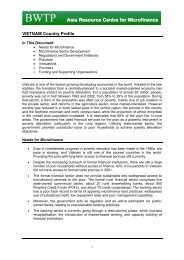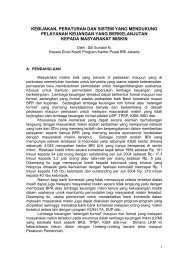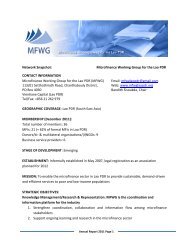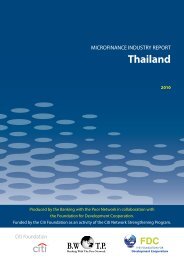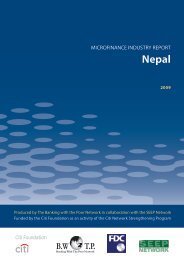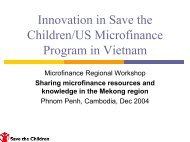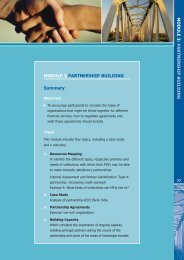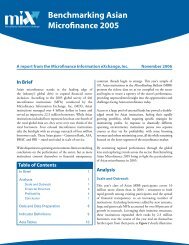microfinance industry report - Vietnam - Banking with the Poor Network
microfinance industry report - Vietnam - Banking with the Poor Network
microfinance industry report - Vietnam - Banking with the Poor Network
Create successful ePaper yourself
Turn your PDF publications into a flip-book with our unique Google optimized e-Paper software.
Table 4. Formal Financial Sector Providers in Viet Nam at a Glance<br />
Type of Institution # Names<br />
State-owned Commercial Banks (SOCBs) 4 VietcomBank, VietInBank, BIVD, and <strong>the</strong> largest bank in Viet Nam: Viet<br />
Nam Bank for Agriculture and Rural Development (VBARD or AgriBank).<br />
Joint Stock Commercial Banks (JSCBs) 37 Asian Commercial Bank (ACB), Sacombank and Techcombank hold<br />
about a third of total JSCB assets 2 .<br />
Joint Venture Banks (JVBs) 5 VinaSiam, Viet Nam-Laos JV Bank and o<strong>the</strong>rs<br />
Foreign owned Banks 28 Citi, ANZ, HSBC among many o<strong>the</strong>rs<br />
Cooperatives 982 People’s Credit Funds and <strong>the</strong>ir apex <strong>the</strong> Central Credit Fund<br />
Policy Lending Banks 2 Viet Nam Bank for Social Policy (VBSP) and Viet Nam Development<br />
Bank (VDB)<br />
Non-Bank Financial Institutions 55 Viet Nam Postal Savings Company (VPSC), 5 sectoral financing<br />
companies, 12 leasing companies and 37 insurance companies.<br />
lend on subsidized and non-market terms. VBSP and<br />
VDB are regulated by SBV and o<strong>the</strong>r government<br />
agencies under <strong>the</strong>ir own specific decrees and are<br />
<strong>the</strong> main vehicles for government transfers.<br />
Non-Bank Financial Institutions include <strong>the</strong> Viet Nam<br />
Postal Savings Company (VPSC), five o<strong>the</strong>r ‘sectoral’<br />
financing companies <strong>with</strong> limited banking licenses, a<br />
growing insurance sector, and 12 leasing companies<br />
affiliated <strong>with</strong> SOCBs or foreign banks.<br />
Viet Nam’s banking sector is often considered both<br />
heavily fragmented and concentrated, and <strong>the</strong><br />
supply market is indeed crowded and complex.<br />
Fragmentation is caused by certain banks being<br />
assigned to specific market segments. VBARD, for<br />
example, is assigned to <strong>the</strong> rural and agricultural<br />
sector. This has, to a certain extent, restrained risksharing<br />
<strong>with</strong>in <strong>the</strong> banking system and has narrowed<br />
<strong>the</strong> borrowing choices of businesses. Concentration<br />
is evident from <strong>the</strong> fact that <strong>the</strong> four dominant<br />
(and one smaller) State-owned Commercial Banks<br />
(SOCBs) account for about 70% of total assets, and<br />
65% of total credit and deposits. The difficulties of <strong>the</strong><br />
transition from a state-controlled to an open, marketled<br />
economy are still apparent in <strong>the</strong> institutional<br />
structure of <strong>the</strong> sector, although credit and deposit<br />
services have increased to all-time highs.<br />
The financial depth of <strong>the</strong> formal financial sector<br />
and <strong>the</strong> existence of policy lenders mean that <strong>the</strong>re<br />
is no clear market delineation between <strong>the</strong> formal<br />
banking sector and <strong>the</strong> <strong>microfinance</strong> market. The<br />
constraints related to fragmentation, concentration,<br />
<strong>the</strong> existence of subsidized policy lenders, and<br />
interest rate controls are affecting <strong>the</strong> entire financial<br />
sector.<br />
2.2 Credit Services<br />
Overall credit grew by 50.6% from 2006 to 2007,<br />
well above <strong>the</strong> 30% target set by <strong>the</strong> government.<br />
In that period, 65.3% of all credit extended by <strong>the</strong><br />
SOCBs and 82.5% of credit provided by o<strong>the</strong>r banks<br />
were for <strong>the</strong> private sector 24 . SOCB credit increased<br />
by a restrained 25% partly due to preparation for<br />
equitization. JSCBs, on <strong>the</strong> o<strong>the</strong>r hand, expanded<br />
credit by an astounding 95% from 2006 to 2007 in an<br />
attempt to gain market shares in <strong>the</strong>ir core market<br />
of private companies, households, and individuals.<br />
Private sector loans accounted for 77% of <strong>the</strong> total<br />
JSCB loans outstanding (2007) and were provided<br />
as consumer loans (35%) and commercial loans to<br />
SMEs.<br />
24 IMF: Viet Nam Country Report 07/386 Statistical Appendix,<br />
December 2007.<br />
<strong>Banking</strong> With The <strong>Poor</strong> <strong>Network</strong> 11<br />
<strong>Vietnam</strong>e_Report_FOR_PRINT.indd 11<br />
27/05/2009 7:46:00 PM



